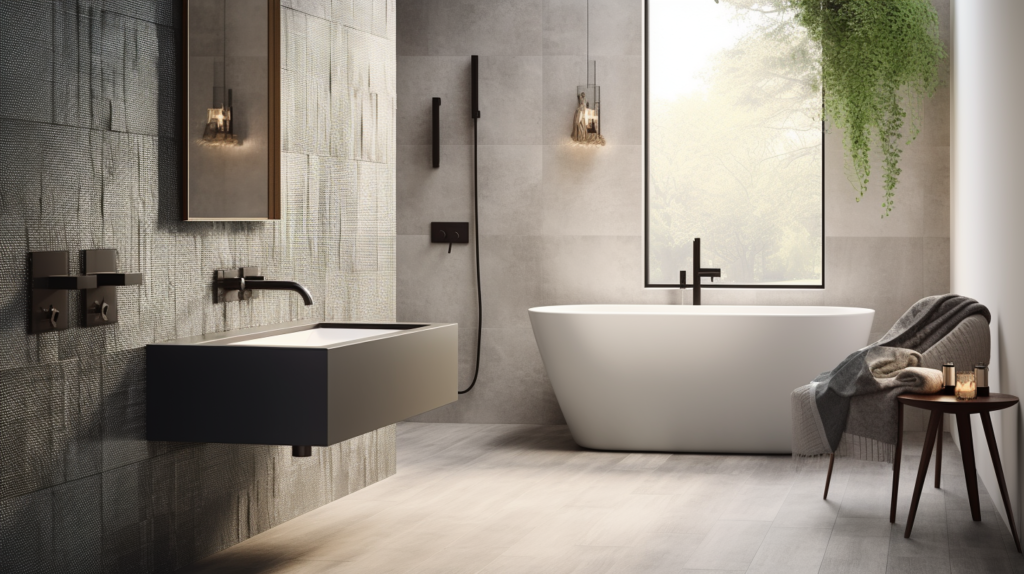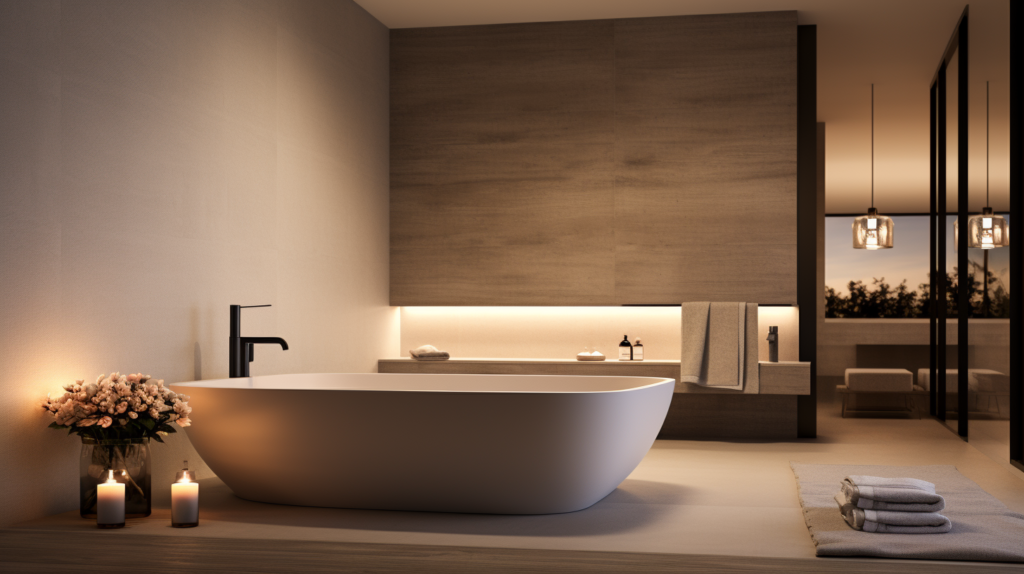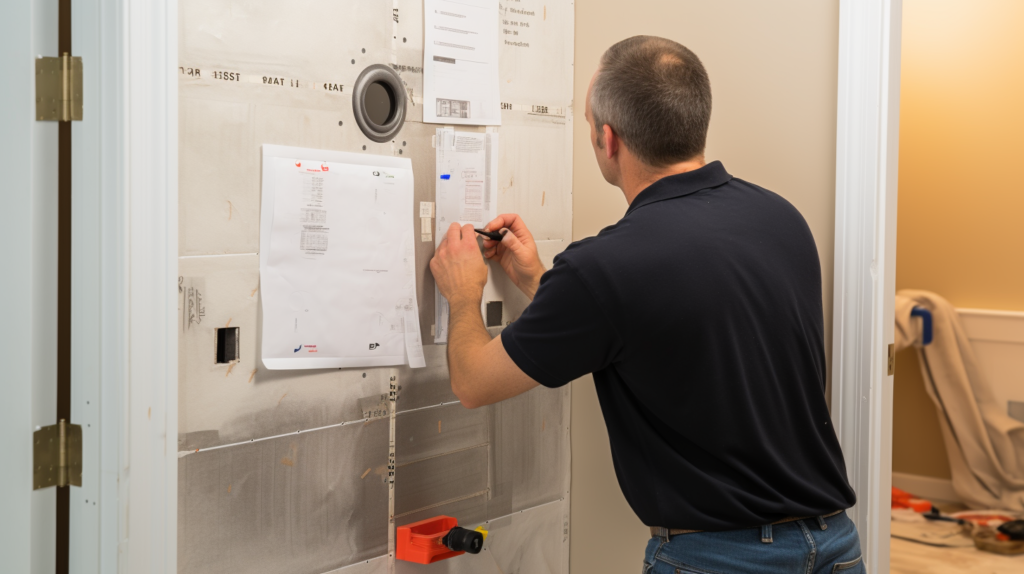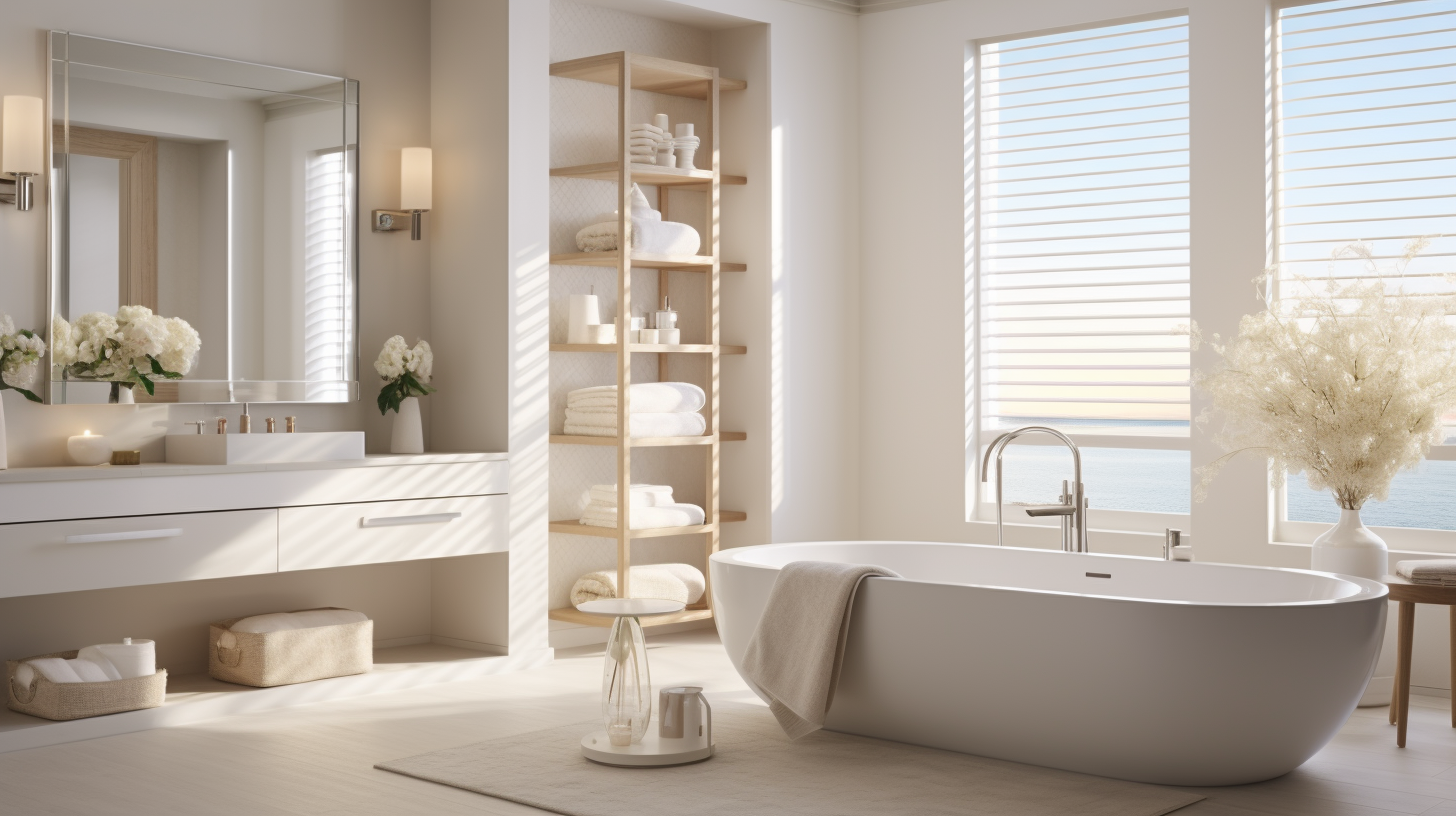Ever cringed at the sound of a toilet flushing or water rushing down the drain, knowing it can be heard by everyone in the house?
It’s a common issue that disrupts not only your peace but also the comfort of tho
Ever cringed at the sound of a toilet flushing or water rushing down the drain, knowing it can be heard by everyone in the house?
It’s a common issue that disrupts not only your peace but also the comfort of those around you.
Soundproofing a bathroom is an essential yet often overlooked aspect of home improvement. Whether it’s the plumbing, the walls, or even the floors, each part plays a role in how sound travels.
The good news is that with the right strategies, you can transform your bathroom into a peaceful haven that preserves your privacy and enhances your home’s overall acoustic environment.
Intrigued about how to turn your bathroom into a sanctuary of silence? Let’s dive in to explore the comprehensive steps you can take to soundproof your bathroom effectively.
The Need for Soundproofing Bathrooms

In today’s fast-paced world, the bathroom is often the only place where one can find a moment of solitude.
This room serves as a personal retreat, a space for self-care and relaxation. Unfortunately, the tranquility that a bathroom should offer is often disrupted by intrusive noises.
Whether it’s the sound of water gushing through pipes or the flushing of a toilet, these are noises you’d rather keep confined within the bathroom walls.
However, this isn’t just about providing a peaceful environment for the person using the bathroom. It’s also about maintaining a sense of comfort for everyone else in the home.
The sounds of a midnight trip to the bathroom can easily wake up other members of the household.
It’s not just about privacy; it’s also about courtesy and fostering a more harmonious living environment for everyone.
Understanding the Types of Noise Inside the Bathroom

Identifying and understanding the types of noise in a bathroom is the first step in any soundproofing project. Plumbing noises are one of the primary culprits.
The sound of water rushing through pipes can be amplified by the acoustics of bathroom tiles and fixtures, making it even more disruptive.
Older homes with outdated plumbing systems may be particularly prone to these types of noises.
Then there’s the category of personal sounds. We all perform activities in the bathroom that we’d rather keep private, both for our comfort and for the comfort of those we live with.
These are the unspoken sounds of the bathroom, activities that everyone engages in but prefers not to discuss openly.
The aim here is to afford people the privacy they need to go about these activities without feeling self-conscious or embarrassed.
Assess Your Bathroom’s Acoustic Weaknesses for Cost-Effective Solutions

A bathroom can have multiple acoustic weak points. It might be the door that’s too thin, or perhaps the walls are poorly insulated.
Maybe it’s the flooring that amplifies every footstep, or the ceiling that does little to contain the noise. Assessing these weak points is essential for two reasons.
First, it allows you to focus your efforts more effectively, ensuring that you’re fixing the actual issues rather than applying unnecessary solutions. Second, it makes the entire process more cost-effective.
Cost-effective soundproofing doesn’t mean opting for the cheapest solutions but rather employing the most effective strategies where they are most needed.
For instance, if your walls are the main issue, then investing in high-quality soundproofing for them makes sense.
On the other hand, if your door is already solid and well-sealed, then you might not need to do anything further in that area. This targeted approach ensures you get the most bang for your buck.
How to Soundproof a Bathroom

Soundproofing a bathroom might initially seem like an overwhelming task, but it doesn’t have to be.
The trick lies in approaching it as a series of smaller projects that collectively contribute to a quieter bathroom.
From the walls and floors to the doors, ceiling, and even the plumbing, each component has its own specific needs and solutions.
Here, we’ll go through each of these elements in detail, discussing the best practices for soundproofing them.
Soundproofing Bathroom Walls
The walls in a bathroom are often different from those in other rooms. Due to the high moisture levels, traditional soundproofing materials like foam panels may not be suitable.
They can absorb moisture over time, leading to the growth of mold and mildew. Therefore, a more specialized approach is required for effective soundproofing.
One of the best times to tackle wall soundproofing is during a renovation when the walls are already open.
At this stage, you can insert soundproofing foam between the wall studs, providing an added layer of sound insulation.
This foam is specially designed to resist moisture, making it ideal for bathroom applications. Once the foam is in place, the wall can be sealed back up, effectively trapping the noise within the room.
If you aren’t planning a renovation any time soon, there are other options. You could add an extra layer of drywall with a sound-dampening adhesive.
This won’t be as effective as internal foam but will still provide some degree of sound insulation. The key here is to make sure that the additional layer is well-sealed to prevent moisture ingress.
Soundproofing Bathroom Floors
Floors are often overlooked when it comes to soundproofing, but they shouldn’t be. Sound can easily travel through floor materials, amplifying the noises generated within the bathroom.
Traditional carpets and rugs are not suitable for bathrooms due to the moisture and potential for mold growth. So, what’s the alternative?
A thick rubber underlayment can be a game-changer. This material serves multiple purposes. Firstly, it provides a moisture barrier, essential in a bathroom setting.
Secondly, it offers excellent sound-dampening properties. Laying this underlayment beneath your existing floor can make a significant difference in the acoustic quality of your bathroom.
For those looking to go the extra mile, a floating floor can be the icing on the cake. This is an additional layer of flooring that sits on top of your existing floor but is not directly attached to it.
This separation provides an added layer of sound insulation. Floating floors come in various materials and finishes, allowing you to match them with your existing bathroom decor.
Soundproofing Bathroom Doors
Your bathroom door is often the weakest link in your soundproofing chain. Most interior doors are hollow-core, providing minimal sound insulation.
Every time you close the door, you’re basically putting up a thin barrier that does little to contain the sounds inside the bathroom.
Upgrading to a solid core door can provide a significant improvement in this area.
Solid core doors are constructed from solid wood or a composite material, making them denser and more effective at blocking sound.
When replacing your door, also consider adding a frame seal kit, which will help soundproof the gaps between the door and the frame.
This is an often overlooked area where sound can escape, and a seal kit can provide an added layer of soundproofing.
Alongside the door itself, the gaps around the door are also a concern. These gaps, especially at the bottom, allow sound to escape, making your soundproofing efforts less effective.
Traditional door sweeps are not recommended as they can scrape against the floor, creating their own set of noises.
Instead, opt for rubber weatherstripping and specialized door bottoms. These create a tight but flexible seal, effectively blocking sound while still allowing the door to open and close smoothly.
Soundproofing Bathroom Ceiling
While walls and floors are usually the first to receive attention in soundproofing projects, the ceiling should not be neglected.
Especially if your bathroom is located on an upper floor, the ceiling becomes a conduit for noise to the lower levels.
One effective method to soundproof a bathroom ceiling is through the installation of a suspended ceiling.
A suspended ceiling involves creating a secondary ceiling below the existing one. The first step is to install joists that will serve as the framework for the new ceiling.
Once the joists are in place, you can add soundproofing foam between them. This foam will serve as an insulating layer that will help trap the sound within the room.
The next step involves installing resilient channels across the joists. These channels are designed to isolate the drywall from the joists, reducing the vibrations that carry sound.
Once the channels are in place, the drywall is installed, completing the secondary ceiling.
This new structure will significantly reduce both airborne and impact noise, making your bathroom a much quieter place.
Soundproofing Plumbing Noises
Plumbing is an integral part of any bathroom, but it’s also a significant source of noise.
From the gurgling of water draining from the sink and bathtub to the flush of the toilet, plumbing noises can be loud and disruptive.
Acoustic pipe lagging offers a solution to this particular challenge.
Acoustic pipe lagging is a specialized soundproofing material designed for pipes.
It is typically made from a combination of mass-loaded vinyl and a decoupling layer, which together serve to both absorb and break up sound waves.
This dual-action effect significantly reduces the noise generated by water flowing through pipes, as well as the sound of draining water.
Installing pipe lagging can be a bit of a project, but it’s well worth the effort. It’s best done during a renovation when the pipes are exposed, but it can also be added to existing plumbing.
The lagging material is wrapped around the pipes and then sealed, usually with a strong adhesive. The result is a dramatic reduction in plumbing noise, rounding out your bathroom’s overall soundproofing.
Optional: Soundproofing Bathroom Ventilation
Ventilation is essential in a bathroom to remove moisture and odors, but it can also be a source of noise.
Standard ventilation fans can be loud, and the sound can carry through the ductwork to other parts of the house. There are a couple of ways to address this issue.
Firstly, you could opt for a silent extractor fan. These are designed to operate at a much lower decibel level than standard fans, reducing the noise generated during operation.
However, replacing an existing fan may not always be practical or cost-effective.
In such cases, soundproofing the existing ventilation can be an alternative. Duct lagging involves wrapping the ventilation ducts in a soundproofing material similar to pipe lagging.
This dampens the sound that travels through the ducts. Another option is to add acoustic foam inside the existing ducts. This material absorbs sound and can be a cost-effective way to reduce noise.
Maintenance and Upkeep

Soundproofing is not a one-time effort but an ongoing commitment. Over time, materials can degrade, seals can loosen, and new weak points can develop.
Regular maintenance is essential to ensure the long-term effectiveness of your soundproofing measures.
A twice-yearly inspection is a good rule of thumb.
During these checks, examine the condition of the seals around your door, the integrity of your pipe and duct lagging, and the state of your wall and floor materials.
If you find any issues, address them promptly to ensure your bathroom remains a sanctuary of peace and privacy.
Conclusion
Soundproofing a bathroom is more than a luxury; it’s a necessity for anyone valuing privacy and tranquility in their home.
By taking a systematic approach to identify the sources of noise and applying effective, targeted solutions, you can transform your bathroom into a peaceful oasis.
From soundproofing the walls, floors, and doors to addressing often-overlooked areas like plumbing and ventilation, this guide offers a holistic roadmap for achieving a quieter bathroom environment.
Moreover, it’s crucial to remember that soundproofing is an ongoing commitment. Regular maintenance checks are essential to ensure that your efforts stand the test of time, providing lasting peace and comfort for you and your family.
Through thoughtful planning, investment in quality materials, and attention to detail, you can create a bathroom that serves not just as a functional space, but as a sanctuary of serenity in a noisy world.
se around you.
Soundproofing a bathroom is an essential yet often overlooked aspect of home improvement. Whether it’s the plumbing, the walls, or even the floors, each part plays a role in how sound travels.
The good news is that with the right strategies, you can transform your bathroom into a peaceful haven that preserves your privacy and enhances your home’s overall acoustic environment.
Intrigued about how to turn your bathroom into a sanctuary of silence? Let’s dive in to explore the comprehensive steps you can take to soundproof your bathroom effectively.
The Need for Soundproofing Bathrooms

In today’s fast-paced world, the bathroom is often the only place where one can find a moment of solitude.
This room serves as a personal retreat, a space for self-care and relaxation. Unfortunately, the tranquility that a bathroom should offer is often disrupted by intrusive noises.
Whether it’s the sound of water gushing through pipes or the flushing of a toilet, these are noises you’d rather keep confined within the bathroom walls.
However, this isn’t just about providing a peaceful environment for the person using the bathroom. It’s also about maintaining a sense of comfort for everyone else in the home.
The sounds of a midnight trip to the bathroom can easily wake up other members of the household.
It’s not just about privacy; it’s also about courtesy and fostering a more harmonious living environment for everyone.
Understanding the Types of Noise Inside the Bathroom

Identifying and understanding the types of noise in a bathroom is the first step in any soundproofing project. Plumbing noises are one of the primary culprits.
The sound of water rushing through pipes can be amplified by the acoustics of bathroom tiles and fixtures, making it even more disruptive.
Older homes with outdated plumbing systems may be particularly prone to these types of noises.
Then there’s the category of personal sounds. We all perform activities in the bathroom that we’d rather keep private, both for our comfort and for the comfort of those we live with.
These are the unspoken sounds of the bathroom, activities that everyone engages in but prefers not to discuss openly.
The aim here is to afford people the privacy they need to go about these activities without feeling self-conscious or embarrassed.
Assess Your Bathroom’s Acoustic Weaknesses for Cost-Effective Solutions

A bathroom can have multiple acoustic weak points. It might be the door that’s too thin, or perhaps the walls are poorly insulated.
Maybe it’s the flooring that amplifies every footstep, or the ceiling that does little to contain the noise. Assessing these weak points is essential for two reasons.
First, it allows you to focus your efforts more effectively, ensuring that you’re fixing the actual issues rather than applying unnecessary solutions. Second, it makes the entire process more cost-effective.
Cost-effective soundproofing doesn’t mean opting for the cheapest solutions but rather employing the most effective strategies where they are most needed.
For instance, if your walls are the main issue, then investing in high-quality soundproofing for them makes sense.
On the other hand, if your door is already solid and well-sealed, then you might not need to do anything further in that area. This targeted approach ensures you get the most bang for your buck.
How to Soundproof a Bathroom

Soundproofing a bathroom might initially seem like an overwhelming task, but it doesn’t have to be.
The trick lies in approaching it as a series of smaller projects that collectively contribute to a quieter bathroom.
From the walls and floors to the doors, ceiling, and even the plumbing, each component has its own specific needs and solutions.
Here, we’ll go through each of these elements in detail, discussing the best practices for soundproofing them.
Soundproofing Bathroom Walls
The walls in a bathroom are often different from those in other rooms. Due to the high moisture levels, traditional soundproofing materials like foam panels may not be suitable.
They can absorb moisture over time, leading to the growth of mold and mildew. Therefore, a more specialized approach is required for effective soundproofing.
One of the best times to tackle wall soundproofing is during a renovation when the walls are already open.
At this stage, you can insert soundproofing foam between the wall studs, providing an added layer of sound insulation.
This foam is specially designed to resist moisture, making it ideal for bathroom applications. Once the foam is in place, the wall can be sealed back up, effectively trapping the noise within the room.
If you aren’t planning a renovation any time soon, there are other options. You could add an extra layer of drywall with a sound-dampening adhesive.
This won’t be as effective as internal foam but will still provide some degree of sound insulation. The key here is to make sure that the additional layer is well-sealed to prevent moisture ingress.
Soundproofing Bathroom Floors
Floors are often overlooked when it comes to soundproofing, but they shouldn’t be. Sound can easily travel through floor materials, amplifying the noises generated within the bathroom.
Traditional carpets and rugs are not suitable for bathrooms due to the moisture and potential for mold growth. So, what’s the alternative?
A thick rubber underlayment can be a game-changer. This material serves multiple purposes. Firstly, it provides a moisture barrier, essential in a bathroom setting.
Secondly, it offers excellent sound-dampening properties. Laying this underlayment beneath your existing floor can make a significant difference in the acoustic quality of your bathroom.
For those looking to go the extra mile, a floating floor can be the icing on the cake. This is an additional layer of flooring that sits on top of your existing floor but is not directly attached to it.
This separation provides an added layer of sound insulation. Floating floors come in various materials and finishes, allowing you to match them with your existing bathroom decor.
Soundproofing Bathroom Doors
Your bathroom door is often the weakest link in your soundproofing chain. Most interior doors are hollow-core, providing minimal sound insulation.
Every time you close the door, you’re basically putting up a thin barrier that does little to contain the sounds inside the bathroom.
Upgrading to a solid core door can provide a significant improvement in this area.
Solid core doors are constructed from solid wood or a composite material, making them denser and more effective at blocking sound.
When replacing your door, also consider adding a frame seal kit, which will help soundproof the gaps between the door and the frame.
This is an often overlooked area where sound can escape, and a seal kit can provide an added layer of soundproofing.
Alongside the door itself, the gaps around the door are also a concern. These gaps, especially at the bottom, allow sound to escape, making your soundproofing efforts less effective.
Traditional door sweeps are not recommended as they can scrape against the floor, creating their own set of noises.
Instead, opt for rubber weatherstripping and specialized door bottoms. These create a tight but flexible seal, effectively blocking sound while still allowing the door to open and close smoothly.
Soundproofing Bathroom Ceiling
While walls and floors are usually the first to receive attention in soundproofing projects, the ceiling should not be neglected.
Especially if your bathroom is located on an upper floor, the ceiling becomes a conduit for noise to the lower levels.
One effective method to soundproof a bathroom ceiling is through the installation of a suspended ceiling.
A suspended ceiling involves creating a secondary ceiling below the existing one. The first step is to install joists that will serve as the framework for the new ceiling.
Once the joists are in place, you can add soundproofing foam between them. This foam will serve as an insulating layer that will help trap the sound within the room.
The next step involves installing resilient channels across the joists. These channels are designed to isolate the drywall from the joists, reducing the vibrations that carry sound.
Once the channels are in place, the drywall is installed, completing the secondary ceiling.
This new structure will significantly reduce both airborne and impact noise, making your bathroom a much quieter place.
Soundproofing Plumbing Noises
Plumbing is an integral part of any bathroom, but it’s also a significant source of noise.
From the gurgling of water draining from the sink and bathtub to the flush of the toilet, plumbing noises can be loud and disruptive.
Acoustic pipe lagging offers a solution to this particular challenge.
Acoustic pipe lagging is a specialized soundproofing material designed for pipes.
It is typically made from a combination of mass-loaded vinyl and a decoupling layer, which together serve to both absorb and break up sound waves.
This dual-action effect significantly reduces the noise generated by water flowing through pipes, as well as the sound of draining water.
Installing pipe lagging can be a bit of a project, but it’s well worth the effort. It’s best done during a renovation when the pipes are exposed, but it can also be added to existing plumbing.
The lagging material is wrapped around the pipes and then sealed, usually with a strong adhesive. The result is a dramatic reduction in plumbing noise, rounding out your bathroom’s overall soundproofing.
Optional: Soundproofing Bathroom Ventilation
Ventilation is essential in a bathroom to remove moisture and odors, but it can also be a source of noise.
Standard ventilation fans can be loud, and the sound can carry through the ductwork to other parts of the house. There are a couple of ways to address this issue.
Firstly, you could opt for a silent extractor fan. These are designed to operate at a much lower decibel level than standard fans, reducing the noise generated during operation.
However, replacing an existing fan may not always be practical or cost-effective.
In such cases, soundproofing the existing ventilation can be an alternative. Duct lagging involves wrapping the ventilation ducts in a soundproofing material similar to pipe lagging.
This dampens the sound that travels through the ducts. Another option is to add acoustic foam inside the existing ducts. This material absorbs sound and can be a cost-effective way to reduce noise.
Maintenance and Upkeep

Soundproofing is not a one-time effort but an ongoing commitment. Over time, materials can degrade, seals can loosen, and new weak points can develop.
Regular maintenance is essential to ensure the long-term effectiveness of your soundproofing measures.
A twice-yearly inspection is a good rule of thumb.
During these checks, examine the condition of the seals around your door, the integrity of your pipe and duct lagging, and the state of your wall and floor materials.
If you find any issues, address them promptly to ensure your bathroom remains a sanctuary of peace and privacy.
Conclusion
Soundproofing a bathroom is more than a luxury; it’s a necessity for anyone valuing privacy and tranquility in their home.
By taking a systematic approach to identify the sources of noise and applying effective, targeted solutions, you can transform your bathroom into a peaceful oasis.
From soundproofing the walls, floors, and doors to addressing often-overlooked areas like plumbing and ventilation, this guide offers a holistic roadmap for achieving a quieter bathroom environment.
Moreover, it’s crucial to remember that soundproofing is an ongoing commitment. Regular maintenance checks are essential to ensure that your efforts stand the test of time, providing lasting peace and comfort for you and your family.
Through thoughtful planning, investment in quality materials, and attention to detail, you can create a bathroom that serves not just as a functional space, but as a sanctuary of serenity in a noisy world.
